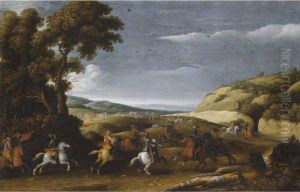Gabriel Francken Paintings
Gabriel Francken, sometimes referred to as Gabriel Francken II to differentiate him from other family members with the same name, was a Flemish painter born in Antwerp around 1616. He belonged to the renowned Francken family, a dynasty of artists that had a significant impact on the art scene in Antwerp during the late 16th and 17th centuries. His father, Frans Francken II, was a prominent painter, and his brothers, Frans Francken III and Constantijn Francken, were also painters. This familial context provided Gabriel with an environment rich in artistic tradition and training from an early age.
Gabriel Francken's works are less documented than those of his more famous relatives, and as a result, his biography is not as well-known. However, it is understood that he became a master in the Antwerp Guild of Saint Luke in 1639, indicating that he was recognized as a professional artist. His career unfolded during a time when the Baroque style was dominant in European art, and the Francken workshop, including Gabriel, contributed to the spread of this style in Flanders.
While specific details about his oeuvre are sparse, Gabriel Francken is known to have created altarpieces, history paintings, and possibly genre scenes. The Francken workshop was famous for its small-scale cabinet paintings, which were collected by the affluent bourgeoisie and nobility of the time. These often depicted religious, mythological, or historical subjects and were noted for their fine detail and intricate compositions.
Gabriel’s date of death is not precisely known, but it is believed he was active until at least 1679. The legacy of the Francken family, including Gabriel Francken, is reflected in their influence on the Flemish art scene of their time, with their works being collected and admired for their craftsmanship and contribution to the Baroque movement in Northern Europe. Nevertheless, due to the collaborative nature of their workshop and the common practice of not signing works, attributions of specific works to Gabriel Francken can be challenging, and some paintings that were once attributed to him have been reattributed to other family members or contemporaries. Therefore, while his individual contributions may be difficult to isolate, his role within the influential Francken workshop is an essential part of the artistic heritage of the period.
